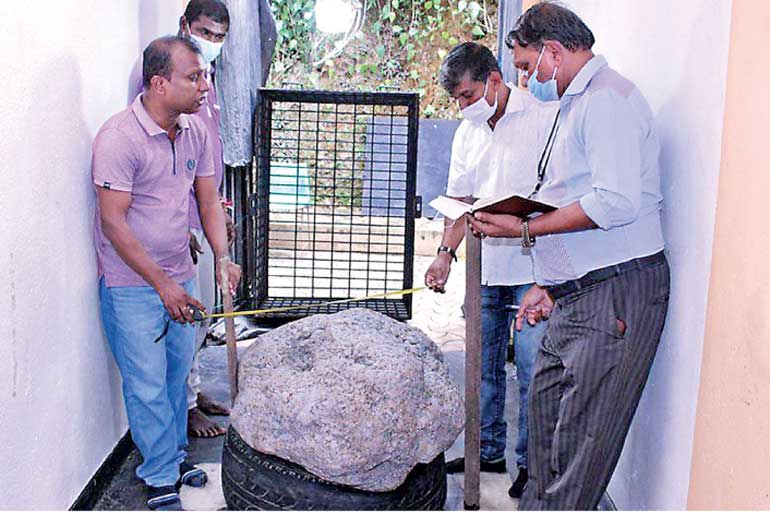Saturday Dec 14, 2024
Saturday Dec 14, 2024
Saturday, 31 July 2021 00:01 - - {{hitsCtrl.values.hits}}

NYTIMES: A tale making the rounds in Sri Lanka this week had all the gleaming ingredients needed to rivet a pandemic-weary nation that had been caught in a cycle of debt even before the coronavirus ravaged the economy.
The world’s largest cluster of sapphires, said to be worth up to $ 100 million (S$ 135 million), had been accidentally discovered by workers digging a well in a gem trader’s backyard, news reports said.
The details, reported this week by the BBC, gave many Sri Lankans something exciting and hopeful to talk about. In the Buddhist-majority country, famous for its gems, many tend to see the discovery of notable gem specimens as spiritually serendipitous, said Daya Amarasekara, a Professor of Sociology at the University of Peradeniya.
“All this time what we heard was negative news about COVID-19,” he said. “So people are drawn to the mental pleasure they get from the news about the gem.”
But some details of the gems’ discovery proved too good to be true. The rock, though real, had not been dug up in a well, but in a gem mine, an official said.
According to the report on 27 July, workmen found the 1,124-pound sapphire cluster more than a year ago while digging the well in Ratnapura, a gem-rich area. An accompanying picture showed a craggy boulder about the size of a car tire.
The report identified the rock’s owner only as Gamage, a third-generation gem trader. He told the BBC that a few stones that had fallen out of the rock as it was being cleaned were later found to be high-quality star sapphires, a type of sapphire known for its optical effect. (A mineral inside the gem reflects light in a star pattern, a phenomenon called asterism.)
The article quoted Thilak Weerasinghe, Chairman of the National Gem and Jewellery Authority of Sri Lanka, a Government agency, as saying that it was “probably the biggest” star sapphire specimen in the world.
Weerasinghe later told The New York Times that the rock had been found in 2020, and that he had kept the news under wraps for months because the pandemic seemed like a bad time to sell sapphires.
He also said that the rock had been hauled out of a gem mine, not a well, and that he had asked journalists to withhold some details from their articles for security reasons. He estimated the sapphires embedded in the rock to be worth $ 100 million.
“It will be a great exhibit for a museum or for someone collecting rare gems,” he added.
At least two Sri Lankan media outlets reported correctly on Wednesday that the gems had been discovered in a mine. “Our story is based on first-hand testimony from the stone’s owner, as well as video evidence of where it was found,” the BBC said in a brief statement. “We stand by our journalism.”
It is not uncommon for some people in Ratnapura to have small-scale gem pits in their backyards. It is also not uncommon for people in Sri Lanka to obscure the details of a gem discovery, said P.R.K. Fernando, President of the Gemmologists Association of Sri Lanka, an industry group. News about such discoveries can sometimes trigger a frenzy of digging. “That can be problematic,” he said.
But he said the news of this discovery could help rejuvenate an industry that had struggled during the pandemic.
On social media, the episode prompted some users to wonder if selling the sapphires would at last generate enough foreign currency to help Sri Lanka escape its punishing debt crisis.
Anushka Wijesinha, an economist in Colombo, said that selling the gemstone for $ 100 million would raise the equivalent of about a third of the annual pre-pandemic export revenues of the country’s gems and jewellery trade.
“But, of course, the full value may not be realised in a one-shot sale,” he added.
David S. Atlas, a gem and jewellery appraiser in Virginia who is chair of ethical issues at the New York City-based National Association of Jewellery Appraisers, said in an email that the estimated value of any large specimen would be highly speculative and “subject to the greatest level of second-guessing”.
Atlas said that while the rock might eventually land in a museum collection and prove highly valuable, “there are many more large specimens in collections already”.
“You just cannot predict the value or the quality of smaller gemstones cut from this big piece of mass material in advance,” he added. “Cut it up, produce the gems found within, and then have it properly examined for value. Then we’ll know a whole lot more.”
Either way, the tale about workers unearthing a rock with precious stones spurred social media users to say – seemingly in jest, but who knows? – that they, too, planned to start digging in their own backyards.